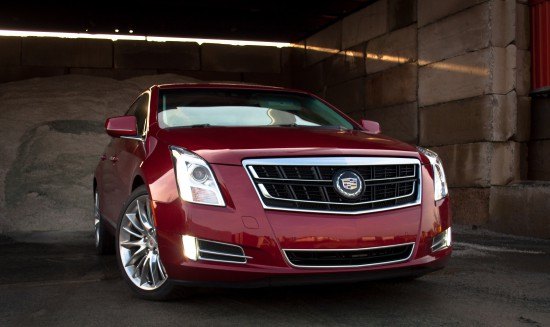Capsule Review: 2015 Cadillac XTS Vsport
GM delivered the Epsilon II platform to the company’s most upmarket division to produce a car with, among other things, more flamboyant styling. Later on, Cadillac added all-wheel-drive, threw in enough equipment to call it a Platinum edition, and by replacing the 3.6L V6 with a twin-turbocharged 3.6L V6, yielded enough straight-line performance to justify the Vsport label.
This all-wheel-drive Cadillac XTS is not an outright Cadillac V car, not like the XLR-V, the STS-V, and what will soon be the third-generation CTS-V. Instead, the Vsport tag, first seen on the third-gen CTS, is a midway point. Except in the XTS’s case, there will be no V, presumably because upping the ante would just be silly, given that the 410-horsepower XTS Vsport already manifests torque steer despite its AWD configuration.
This, therefore, is Maximum XTS, the latest, flashiest, fastest car in a long line of big Cadillacs stretching back to your grandfather’s Fleetwood Brougham and his boss’s post-war Sixty Special.
In the United States, a base front-wheel-drive XTS starts at $45,655, destination fees included. $51,995 is the starting point for the all-wheel-drive XTS. The Vsport model begins at $63,730, but the Vsport Platinum ($70,780) can be optioned up beyond $72,000 with rear seat DVD. The XTS Vsport is rated by the EPA at 16 mpg in the city; 24 on the highway. Our XTS Vsport Platinum, supplied for the week by GM Canada, averaged 16 mpg over the course of the week and was priced at (CAD) $77,565 with fees and options, including $1295 for the lustrous crystal red tintcoat.
The sense of high quality is deeper than the paint. Moving inside, the XTS’s headliner and pillars are slathered in alcantara. There’s real wood sourced from real trees. Four of the 14 Bose speakers are perched just above the front occupants’ shoulders for impressive surround sound audio. CUE, though sluggish and frustrating when in use, makes for a stylishly minimalistic flip-up centre panel. The XTS Vsport’s gauge cluster is light years beyond the setup so often decried in the ATS.
Moreover, if “premium” and “luxury” and “upscale” still go hand in hand with acreage, the XTS is a winner regardless of equipment levels and material quality. It’s 19.2 inches longer than the ATS, 6.5 inches longer than the CTS, with a cabin that’s 7.4% larger than the CTS’s. If you want bigger luxury, long-wheelbase Germans are the way to go. The Audi A8L is 5.4 inches longer with 2.9 inches of extra rear legroom and a cabin that’s 17% larger. But the A8L, like most cars, can’t beat the XTS’s 18 cubic feet of cargo capacity.
(Compared with the final version of its DTS successor, the XTS is 5.6 inches shorter and nearly two inches narrower with marginally less rear legroom and 2.4 fewer inches of rear hiproom. The trunk and the overall cabin size are both slightly smaller than they were a generation ago, as well.)
Fortunately, once on the move the XTS doesn’t feel as immense as its dimensions suggest. Visibility is far better than in the smaller CTS and the XTS’s steering is more than light enough to ease slow-speed maneuvering. Naturally, there’s a lot of weight (4215 pounds) to toss around a corner. That avoirdupois, combined with slow and feathery steering and braking response that’s not up to the standards of modern performance cars, discourages the truly aggressive driving which the CTS Vsport constantly invites. Yet at the same time, the XTS performs the trick of driving like a somewhat (and only somewhat) smaller car, which becomes its most encouraging dynamic trait.
Still, the general lack of any feeling or connection causes you to question the legitimacy of the V badge on the XTS’s trunklid, if you haven’t already. But the road will open up, and when it does, you’ll be taken aback by the instant-on torque (369 lb-ft at just 1900 rpm) and the seemingly endless wave of power. As the speedometer’s readout climbs higher and you anticipate an ocean’s worth of disconcerting float, Magnetic Ride Control keeps body motions in check. The XTS Vsport’s ride quality isolates road imperfections to the extent that passengers were never aware of the imperfections. And though wind noise, more noticeable because of the otherwise hushed interior, barely creeps in around the A-pillars, passengers are not aware of the actual rate of speed.
Remembering the potency of this engine, you didn’t reach such speeds quite as quickly as you expected. The 3.6L twin-turbo makes 10 more horsepower and 61 more lb-ft of torque when placed under the hood of the CTS Vsport, which weighs less than 4000 pounds and sends power to the rear wheels with an 8-speed automatic. By the standards of that car’s transmission, the XTS Vsport’s 6-speed automatic is sluggish, but its all-around smoothness will be appreciated by the XTS’s dwindling clientele.
U.S. XTS sales are down 26% to just 22,059 units through the first eleven months of 2014. Thus, it may not have mattered if the XTS Vsport was equipped with a Hellcat-like V8 and ZF’s famed 8-speed automatic, as this still wouldn’t be a vehicle in which the typical car buyer of today has any interest. (And does the typical buyer of yesterday have any interest in battling the Cadillac User Interface on a daily basis?) Though relatively fleet-friendly, the XTS sells less often than the far pricier and recently redesigned Mercedes-Benz S-Class; more often than the Audi A6, Buick Regal, and Lexus GS. Cadillac sold more than 80,000 Devilles as recently as 2003, a year in which Lincoln sold more than 56,000 Town Cars.
The market has moved away from traditional full-size sedans and is moving away from Cadillac’s car division, too. The brand’s passenger cars are down 15% to 79,139 units with one month remaining in 2014 as Cadillac reportedly pursues a premium image not in keeping with price cuts.
Indeed, ever since the as-tested price was mentioned, you’ve been wanting to pipe in with the names of countless other cars available at a similar price point: BMW 550i xDrive, Lexus LS460, Audi A7 TDI, and Jaguar XJ, cars with reputations for athleticism, refinement, technological prowess, and panache which Cadillac can’t match. That might be missing the point. The XTS Vsport won’t be the car you buy because of how well it stacks up against the competition. It’s the XTS you buy because you were going to buy an XTS anyway, and this is the maximized XTS.
Of course, I wasn’t going to buy a regular 304-horsepower XTS. Sales figures suggest you weren’t going to either. But I won’t deny that for the prospective XTS buyer, this Vsport provides the kind of accelerative experience that makes the conventional XTS feel dreadfully pedestrian.
Timothy Cain is the founder of GoodCarBadCar.net, which obsesses over the free and frequent publication of U.S. and Canadian auto sales figures.
More by Timothy Cain
Latest Car Reviews
Read moreLatest Product Reviews
Read moreRecent Comments
- ToolGuy 9 miles a day for 20 years. You didn't drive it, why should I? 😉
- Brian Uchida Laguna Seca, corkscrew, (drying track off in rental car prior to Superbike test session), at speed - turn 9 big Willow Springs racing a motorcycle,- at greater speed (but riding shotgun) - The Carrousel at Sears Point in a 1981 PA9 Osella 2 litre FIA racer with Eddie Lawson at the wheel! (apologies for not being brief!)
- Mister It wasn't helped any by the horrible fuel economy for what it was... something like 22mpg city, iirc.
- Lorenzo I shop for all-season tires that have good wet and dry pavement grip and use them year-round. Nothing works on black ice, and I stopped driving in snow long ago - I'll wait until the streets and highways are plowed, when all-seasons are good enough. After all, I don't live in Canada or deep in the snow zone.
- FormerFF I’m in Atlanta. The summers go on in April and come off in October. I have a Cayman that stays on summer tires year round and gets driven on winter days when the temperature gets above 45 F and it’s dry, which is usually at least once a week.





































Comments
Join the conversation
Not to be "that guy" but my expectation of this car's transmission lifespan is approximately 3 months past when the warranty expires. -it's a transverse box where everything is crammed in -hooked up to AWD -Towing around like 4500lbs -making peak torque at 1900rpm of like 370lb-ft -they detuned the motor drastically to make it "safe" for this if my experience with the 4T65EV-GT in the 99-04 Volvo S80 T6 is any clue, I think this will chew through transmissions even faster than those cars did. It would be fun for the three years or so it ran to spank Z-cars and stuff off of traffic lights in a car that doesn't look remotely special or interesting, but not 70 grand worth of fun for a car based on a 30-grand Buick LaCrosse.
Where does Cadillac get off asking that much for this car. But I can recall a few special edition Town cars and Cadillac's going for over $55,000 in the late 90's early 2000's. Sooo i guess they arn't out of line here. But i have to admit this is the last of the body styles I like from Cadillac. The new models are horrible looking. The last Caddy I liked was the early 2000's Deville. Call me old school but I would bet you those will age better on the eyes then any modern jagged edged caddy today